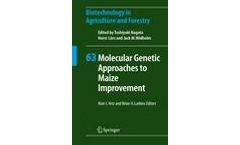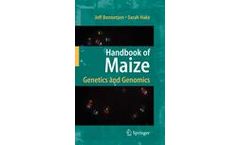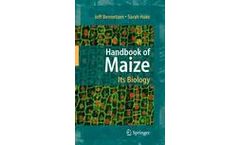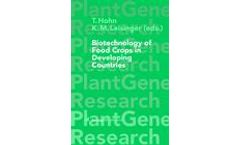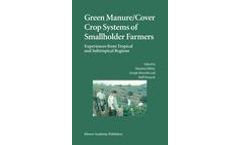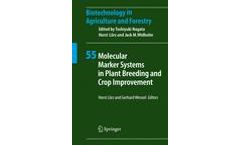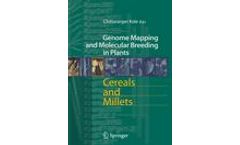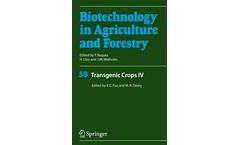Refine by
maize books
16 books found
Forty chapters deal with various aspects of tissue culture, in vitro manipulation, and other biotechnological approaches to the improvement of maize. They are arranged in eight sections: - In Vitro Technology, Callus Cultures and Regeneration of Plants, Somatic Embryogenesis. - Wide Hybridization, Embryo, Ovule, and Inflorescence Culture, in Vitro Fertilization. - Production of ...
As increasing global population and continuing economic development ensure the need for further production and cultivation of maize, the necessity of the application of transgenic technology to this model species and crop plant grows steadily. In Transgenic Maize: Methods and Protocols, experts in the various disciplines of the field contribute readily ...
During the past decade, there has been tremendous progress in maize biotechnology. This volume provides an overview of our current knowledge of maize molecular genetics, how it is being used to improve the crop, and future possibilities for crop enhancement. ...
Maize is one of the world’s highest value crops, with a multibillion dollar annual contribution to agriculture. The great adaptability and high yields available for maize as a food, feed and forage crop have led to its current production on over 140 million hectares worldwide, with acreage continuing to grow at the expense of other crops. In terms of tons of ...
Maize is one of the world’s highest value crops, with a multibillion dollar annual contribution to agriculture. The great adaptability and high yields available for maize as a food, feed and forage crop have led to its current production on over 140 million hectares worldwide, with acreage continuing to grow at the expense of other crops. In terms of tons of ...
Kernel number per plant is the yield component primarily responsible for variation in maize grain yield across environments. The authors highlight recent discoveries regarding the roles of carbohydrate, nitrogen, and phyto-hormone metabolism in controlling kernel formation. ...
This text and reference discusses the drying of grains, in particular the staple cereals, maize, rice, and wheat, and the oilseeds, soybeans and canola. The basic physical and thermodynamic properties of grain and air are examined, and the theory of the drying process is developed. ...
Farmers, Gene Banks and Crop Breeding: Economic Analyses of Diversity in Wheat, Maize, and Rice responds to concerns about the loss of valuable genetic resources and crop vulnerability arising from widespread cultivation of genetically uniform varieties. ...
Tropical crops such as cowpea, yam, plantain, and cassava are heavily underresearched but, in addition to rice, maize, wheat, and potato, are important as primary or secondary food staples in the developing countries. ...
In the 1980s and 1990s, green manure/cover crop (GMCC) systems became a popular agricultural technology in research and development efforts for smallholder tropical and subtropical farmers. However, few syntheses of these experiences have been conducted. This volume of case studies contributes to bridging this gap by reviewing field-level experiences with these systems. Twelve case studies are ...
Successful release of new and better crop varieties increasingly requires genomics and molecular biology. This volume presents basic information on plant molecular marker techniques from marker location up to gene cloning. The text includes a description of technical approaches in genome analysis such as comparison of marker systems, positional cloning, and array techniques in 19 crop plants. A ...
The incorporation of haploids in breeding programs is one of the latest techniques used for crop improvement. The present volume comprises 30 chapters by international experts and informs on the methods involved, such as in vitro production of haploids by culture of anthers, studies of pollen embryogenesis, genetic analysis of haploids. It also discusses the genetic stability of haploid cell ...
Heterosis breeding based on male sterility has become established in many field crops and has been credited with high productivity. This book presents an update on the advent and promise of hybrids with comprehensive coverage of theoretical and applied aspects of heterosis breeding. Its principal elements are the hybrid advantage, pollination control mechanisms and finally the production of ...
With limited water resources to divert for agriculture, innovations aimed at increasing efficient use of irrigation water must be developed. Among the means to survive the consequences of water scarcity and yet to sustain high crop production under irrigated agriculture with decreasing share of water, deficient irrigation programs are highly valued and their adoption is widely promoted. ...
Genome Mapping and Molecular Breeding in Plants presents the current status of the elucidation and improvement of plant genomes of economic interest. The focus is on genetic and physical mapping, positioning, cloning, monitoring of desirable genes by molecular breeding and the most recent advances in genomics. The series comprises seven volumes: Cereals and Millets; Oilseeds; Pulses, Sugar and ...
Genetic engineering is a powerful tool for crop improvement. Crop biotechnology before 2001 was reviewed in Transgenic Crops I-III, but recent advances in plant cell and molecular biology have prompted the need for new volumes. Transgenic Crops IV deals with cereals, vegetables, root crops, herbs and spices. Section I is an introductory chapter on the impact of plant biotechnology in agriculture. ...



